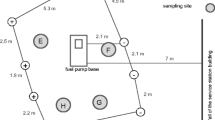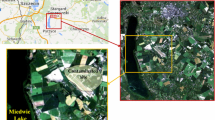Abstract
Work in this paper describes the results of a field and modeling study conducted to investigate the extraction of LNAPL (jet propellant 4, i.e., JP-4, jet fuel) using Prefabricated Vertical Wells (PVWs) at a former air force base. Field testing consisted of 185 operating hours on 25 rows, each consisting of 7 or 8 PVWs. A total of 133 L of free-phase liquid is removed from the subsurface in addition to 467 kg of organics in the vapor phase as a result of volatilization due to the application of vacuum heads exceeding the JP-4 vapor pressure. Monitored field data are used to calibrate a numerical model for investigating the effect of irreducible water content, LNAPL, and gas contents on system performance. Analysis results show that increasing the irreducible water content from 5 % to 20 % decreases the free-LNAPL specific volume from 0.08 m to 0.067 m, which led to reduction in removal efficiency. Under a continuous saturation condition, more wetting fluid (water), traps the nonwetting fluid (LNAPL) in the soil pores, and reduces its mobility, which eventually impedes the LNAPL recovery. Given the model parameters that simulate field conditions, the PVWs show best removal rates in the gas phase. The model results indicated that 292 L of JP-4 can be recovered in 19.5 days (based on 8 h of operation per day) with an effective rate of 1.87 L/h. At the end of 4.25 years of system operation, the maximum benzene concentration is 0.002 ppm. At a gas extraction rate of 10,273 L/min, a maximum concentration of 0.38 ppm in the vapor phase is achieved after 2.5 years of vapor extraction.












Similar content being viewed by others
References
Adams JA, Reddy KR (2000) Removal of dissolved- and free-phase benzene pools from ground water using in situ air sparging. J Environ Eng 126:697–707
Alferi M, Dominijanni A, Manassero M (2010) Soil remediation by high vacuum extraction techniques. In: Proceedings of international congress on environmental geotechnics, 6th ICEG, 8–12 Nov 2010, New Delhi, India, McGraw Hill, New Delhi
Anderson MP (1984) Movement of contaminants in groundwater: groundwater transport-advection and dispersion. Groundwater contamination, studies in geophysics. National Academy Press, Washington, pp 37–45
ASTM D 422-63 (2007) Standard test method for particle-size analysis of soils. http://www.astm.org/Standards/D422.htm (October 2008)
ASTM D 6282-98 (2008) Standard guide for direct push soil sampling for environmental site characterizations. http://www.astm.org/DATABASE.CART/HISTORICAL/D6282-98.htm (16 May)
Bartow G, Davenport C (1995) Pump-and-treat accomplishments: a review of the effectiveness of ground water remediation in Santa Clara Valley, California. Ground Water Monit Rev 15(2):140–146
Bedient PB, Rifai HS, Newell CJ (1999) Groundwater contamination transport and remediation, 2nd edn. Prentice Hall, Englewood Cliffs. ISBN-0-13-013840-1
BIOSLURP (2004) Technical documentation and user guide. Resources and System International, Inc., Blacksburg
Braida W, Ong SK (2000) Influence of porous media and airflow rate on the fate of NAPLs under air sparging. Transp Porous Media 38:29–42
Brooks RH, Corey AT (1966) Properties of porous media affecting fluid flow. J Irrigation Drainage Div Am Soc Civil Eng 92:61–87
Cagle GA et al (1997) Combining in situ technologies in low-permeability soil, a case study. In: Proceedings of the 1997 ASCE annual fall national convention, October, Minneapolis, MN, pp 297–311
Carsel RF, Parish RS (1988) Developing joint probability distribution of soil water retention characteristics. Water Resour Res 24(5):755–769
Charbeneau RJ (2000) Groundwater hydraulics and pollutant transport. Waveland Press, Inc., Long Groove
Chemical Rubber Company (CRC) (1984) In: Weast RC (ed) CRC handbook of chemistry and physics, 65th edn. CRC Press, Inc., Boca Raton
Gabr MA, Bowders JJ, Woksien S (1995) Prefabricated vertical drains (PVDs) for enhanced soil flushing. Geoenvironment 2000, New Orleans, pp 1250–1264
Gabr MA, Bowders JJ, Wang J, Quaranta J (1996) In situ soil flushing using prefabricated vertical drains. Can Geotech J 33(1):97–105
Haley JL, Hanson B, Enfield C, Glass J (1991) Evaluating the effectiveness of ground water extraction systems. Ground Water Monit Rev 11(1):119–124
Interstate Technology & Regulatory Council LNAPLs Team (2009) Evaluating LNAPL remedial technologies for achieving project goals. Interstate Technology & Regulatory Council, Washington
Katyal AK, King LG (1988) ‘Three dimensional upstream finite element model for reactive solute transport in variably saturated porous media. In: Proceedings of the international summer meeting of the ASAE, American Society of Agricultural Engineers, St. Joseph, Mich
Kramer J, Lesson A, Headington G, Walton S, Eastep J (1997) Free recovery testing at the sites 27 & 28, Nellis AFB, Nevada. Report by Battelle to US Airforce Center for Environmental Excellence, Brooks AFB, Contract no. F41624-94-c-8012, Texas, Nov 1997, 87 pp
Kunberger T, Quaranta JD, Gabr MA (2003) Remediation of former Lockbourne Air Force Base using well injection depth extraction (WIDE). In: 12th Panamerican conference on soil mechanics & geotechnical engineering, June, Cambridge, MA, pp 1575–1581
Lesson A, Cumming L, Wheeler M, Headington G (1997) Free recovery testing at the 290 fuel Yard and North Tank Area, Tinker AFB, Oklahoma. Report by Battelle to US Airforce Center for Environmental Excellence, Brooks AFB, Contract no. F41624-94-c-8012, Texas, May 1997, 149 pp
Lyman WJ, Reehl W, Rosenblatt F, David H (1993) Handbook of chemical property estimation methods. McGraw-Hill, New York
Manassero M, Dominijanni A, Musso G (2009) Modelling applyed to environmental geotechnics. In: Proceedings of international symposium on geoenvironmental engineering. ISGE2009, 8–10 Sept 2009, Hangzhou, China, Spinger, Dordrecht
Newell CJ, Steven DA, Ross RR, Huling SG (1995) Light non-aqueous phase liquids, Groundwater issue. EPA/540/S-95/500
Norris RD, Hinchee RE, Brown R, McCarty PL, Semprini L et al (1994) Handbook of bioremediation, 1st edn. Lewis Publishers, Boca Raton, 257 pp
Ohio EPA (1995) Technical guidance manual for hydrogeologic investigations and ground water monitoring (Chapter 10), Division of Drinking and Groundwater, Columbus, Ohio
Oostrom M, White MD, Lenhard RJ, Geel PJV, Wietsma TW (2005) A comparison of models describing residual NAPL formation in the vadose zone. Vadose Zone J 4, 163–174 pp
Peignenburg WJGM, Damborsky J (1996) Biodegradability prediction. Kluwer Academic Publishers, Dordrecht
Robertson BK, Alexander M (1996) Mitigating toxicity to permit bioremediation of constituents of nonaqueous phase liquids. Environ Sci Technol 30:2066–2070
Rosenzweig JJ, Abelmalek NA, Gochnour JR (1986) The development of pseudo functions for three phase black oil simulators. In: Lake LW, Carroll HB Jr (eds) Reservoir characterization. Academic Press, New York, pp 393–443
Sharmin N (2009) Performance optimization of LNAPL three phases extraction by prefabricated vertical wells (PVWs, Doctoral Thesis/Dissertation, North Carolina State University, 269 pp
Steffensen WS, Alexander M (1995) The effect of competition for available nutrients in systems containing mixtures of substrates. Appl Environ Microbiol 61:2859–2862
Travis CC, Doty CB (1990) Can contaminated aquifers at superfund sites be remediated? Environ Sci Technol 24(10):1464–1466
Van Genuchten MT (1980) A closed-form equation for predicting the hydraulic conductivity of unsaturated soils. Soil Sci Soc Am J 44:892–898
Waduge WAP, Soga K, Kawabata J (2004) Effect of LNAPL entrapment conditions on air sparging remediation efficiency. J Hazard Mat 110:173–183
Warren KA, Gabr MA, Quaranta JD (2006) Field study to investigate WIDE technology for TCE extraction. J Geotech Geoenviron Eng 132(9):1111–1120
Williams DE, Wilder DG (1971) Gasoline pollution of a ground-water reservoir—A case history. Ground Wat 9(6):50–54
Xie G, Barcelona MJ (2003) Sequential chemical oxidation and aerobic biodegradation of equivalent carbon number-based hydrocarbon fractions in jet fuel. Environ Sci Technol 37(20) (Oct):4751–4760
Yen HY, Chang NB (2003) Using the bioslurping model to assess the light hydrocarbon recovery in contaminated unconfined aquifer I: simulation analysis. Pract Period Hazard, Toxic, Radioact Waste Manag 7(2) (April):114–130
Acknowledgments
Many individuals and organizations contributed to this project’s overall accomplishments. The Principal Investigators wish to thank US Army Corps of Engineers, Louisville District, Nashville District, Huntington District, for their programmatic support. We are deeply grateful to the late Mr. John Sneberger, Environmental Support Services, who was the field technician for the project. This paper is dedicated to his memory.
Author information
Authors and Affiliations
Corresponding author
Rights and permissions
About this article
Cite this article
Gabr, M.A., Sharmin, N. & Quaranta, J.D. Multiphase Extraction of Light Non-aqueous Phase Liquid (LNAPL) Using Prefabricated Vertical Wells. Geotech Geol Eng 31, 103–118 (2013). https://doi.org/10.1007/s10706-012-9567-5
Received:
Accepted:
Published:
Issue Date:
DOI: https://doi.org/10.1007/s10706-012-9567-5




